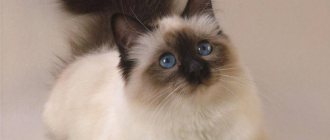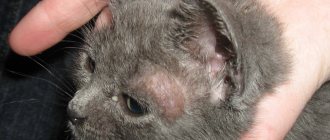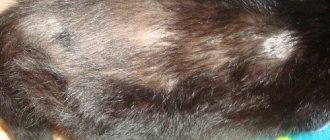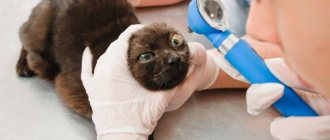Ringworm in cats - how to treat, how to recognize and overcome this common disease? First of all, you need to clearly understand that a fungal disease does not go away without therapy, the animal’s condition will only worsen and move from a local to a generalized form.
Young cats, pets with weakened immune systems, and those who walk outside without supervision are most susceptible to infection. At the same time, lichen is not a death sentence; it responds well to treatment if it is prescribed by a competent veterinarian.
What is lichen
Ringworm is a generalized name for a group of dermatological diseases, the causes of which can be different. Feline ringworm externally manifests itself as small itchy nodular lesions, devoid of hair. How to treat lichen in a cat and how long the therapy will be depends on whether it belongs to a particular species:
- Weeping - it can be caused by a sharp change in hormonal levels in the body, nervous shock, an allergic reaction, infection with helminths, ticks or common fleas, the affected area is painful.
- Pink or shingles - diagnosed in animals more often than others, can occur at any age, and is caused by a herpes virus.
- Multi-colored - you need to quickly decide how to treat feline lichen, since this type of disease is dangerous for people. The disease is manifested by the formation of a small round-shaped spot with a changing color.
- Flat red – its onset is provoked by a failure of the immune system. The reason is a long-term chronic disease or infection.
- Ringing – manifests itself as a deterioration in the quality of the coat, disruption of the structure of the hairs, then a rash appears. At an advanced stage, focal baldness occurs.
There are other types such as Scab caused by the Achorion fungus. It poses a danger to people who are in contact with an infected animal. The disease affects the skin, claws, and in advanced cases spreads to internal organs, but extremely rarely threatens the life of the pet.
Tablets for lichen
Antifungal medications taken orally, in tablet form:
- Griseofulvin (analogs Gricin, Fulcin, etc.). Intended for the treatment of humans, but can also be used for cats. The dosage depends on the weight of the pet - 40 mg/kg, given half or a whole tablet crushed into powder twice a day with food. The medicine has side effects (diarrhea, nausea, liver damage, lethargy) and contraindications.
- Itraconazole (or similar drugs Irunin, Orungal, etc.). Available in tablets and capsules, for cats the dosage is ¼ tablet twice a day (for kittens - 1/8 tablet or capsule, depending on the pet’s weight 10 mg/kg). Give with food for 7 days, then another 2 weeks - every other day in the same amount. The course of treatment is from 4 to 6 weeks. Possible side effects such as nausea and decreased appetite.
- Terbinafine (analogs Lamisil, Exifin). It is given to animals at the rate of 30 mg per kilogram of weight for 3-4 weeks, and is also used in kittens. Side effects include loss of appetite and allergic reactions due to individual intolerance.
In addition, there are drugs in the form of injections. One of them is Dermikotsid, which is an antifungal drug for the treatment of microsporia and trichophytosis. Injections are given into the thigh muscles 2-3 times with an interval of 5 days. For kittens, the dosage is 0.5 ml, for adult pets - 1-1.5 ml. The drug has side effects in the form of an individual reaction on the skin (urticaria, rash), the appearance of redness in the eyes and mucous membranes of the mouth.
How the disease spreads
To know how to cure a cat from lichen and prevent re-infection, you need to know how the disease spreads.
Infection is possible only through direct or indirect contact with an infected animal or person, as well as through:
- fungal spores brought from the street on shoe soles;
- sticks, objects, toys, leftover food from a sick animal.
Interestingly, contact with a carrier of a fungal infection will not necessarily lead to your pet developing feline lichen; treatment may not be necessary. If the cat has a strong enough immune system and there are no cracks or wounds on its skin, then the disease may pass by.
Causes of lichen
Fungi that cause the development of lichen can be found in grass, soil, or the fur of other animals, and are very viable. Outdoor cats are mostly susceptible to deprivation. However, a domestic cat can be infected by an owner who brought the infection on the surface of his clothing or the soles of his shoes.
The infection is not a serious threat to an adult cat with good immunity. If the animal has experienced great stress, the risk will increase.
Kittens are most susceptible to infection, since their immune system has not yet developed. Animals with other pathologies are also at risk. Poor quality nutrition, wounds and abrasions on the pet’s skin - all this only contributes to lichen infection.
How dangerous is lichen for humans?
Despite the fact that we are talking about a highly contagious disease, a timely prescribed remedy for lichen in cats and compliance with precautions leads to the fact that no more than 3% of contact people become infected. Therefore, if your pet has contracted a fungal infection, do not rush to get rid of it, find out how to cure a cat of lichen, be patient and wait for a complete recovery.
If you are unlucky and become infected with spores, do not panic. This is a harmless disease; in people it is mild and responds well to therapy. To prevent the development of an undesirable scenario, when in contact with a sick animal, wear disposable gloves, change clothes, and isolate the infected pet in a separate room.
Information about the disease
Ringworm in cats is an infectious disease caused by two types of microscopic fungi: Mycrosporum and Trichophyton.
In the first case, the type of lichen is called microsporia, and in the second - trichophytosis. The clinical symptoms of both pathologies are identical.
Microsporia and trichophytosis fungi quickly reproduce by spores, therefore they are very widespread in the environment. These fungal spores can be found anywhere other cats infected with the disease have been.
A decrease in the animal's immunity can cause this disease. To strengthen the animal’s body’s defenses, it is necessary to get vaccinated and know what to feed the cat.
Fungal spores can remain viable in the external environment for up to two years. They are highly resistant to adverse conditions and many disinfectants.
The risk of contracting ringworm for a cat is very high. However, the body of adult and healthy felines has the ability to successfully resist this disease.
Who is at risk
- Kittens up to 1 year.
- Sick animals.
- Cats with weakened immune systems in the postoperative period or after illnesses.
- Free-ranging animals.
You might be interested in:
- scabies in cats.
Symptoms
Before we talk about how to treat a cat for lichen, you need to understand the symptomatic picture.
You should be alert to the following signs:
- hair loss in local areas of the skin;
- purulent formations, vesicular nodes, and scaly discharge are visible on the lesions;
- there is annoying itching;
- in some cases, when the lesion affects a large area of the body, peeling appears and the coat becomes greasy and unkempt.
Despite everything, the first symptoms of the disease remain increased shedding, balling of fur, anxiety, frequent scratching, and the appearance of an unpleasant white coating in the undercoat.
Treatment of deprivation
The treatment tactics for lichen are determined by the form and nature of the disease. In many cases, it is enough to put a protective collar on the cat against licking and promptly treat the affected areas of the skin with ointments; in severe cases, therapy should be comprehensive with the use of tablets, injections, and external agents.
It takes 2 weeks for skin wounds to heal, but complete recovery occurs in 4-6 weeks, provided that all the veterinarian’s recommendations are strictly followed.
Tablets, injections, and external remedies help to cope with ringworm. Before treating the sore spot, the hair around it is shaved off for better contact of the medicine with the skin. The list of drugs needed to treat ringworm:
- antifungal sprays (Dermazol, Nizoral);
- ointments (Yam, Lamisil, Miconazole);
- tablets (Terbinafine, Itraconazole, Griseofulvin).
Vaccines are used to treat and prevent disease in cats.
Diagnostics
As with other diseases, only a veterinarian can make a diagnosis, confirm or refute your guesses.
The doctor will conduct a comprehensive examination:
- using a Wood's lamp, examine the affected area; the primary method will most likely indicate the presence of lichen - if the diagnosis is confirmed, the fur under the lamp will acquire a green tint;
- examination under a magnifying microscope makes it possible to examine skin scales in detail and see microsporia on the skin or hairs;
- analysis of the scraping for the presence of a nutrient medium - for analysis, a scraping is made from the affected area and sent to the laboratory to identify parasites and fungi.
The first two methods are carried out directly in the doctor’s office, take a few minutes, but do not give a 100% result. The culture is analyzed within 21 days, and its reliability is 100%.
Treatment with drugs
Treatment of lichen is carried out comprehensively and systematically using the following anti-lichen drugs prescribed by a veterinarian:
- Vaccines for the treatment of ringworm (trichopytosis and microsporia) - Vakderm F, Polivac TM, which are administered intramuscularly in the area of the femoral muscle 1-2 times with an interval of 2 weeks. Used at the initial stage of the disease.
- Ointments with antimycotic action. Used for local treatment.
- Special shampoos with antifungal ingredients (Nizoral with ketoconazole, Doctor skin shampoo, Antiseptic & Antifungal vet shampoo). They are an addition to the main course of treatment, because help reduce itching, have a positive effect on the skin and speed up recovery. Before use, the area around the affected area must be shaved and treated with an antiseptic.
- Sprays for animals (Fungin, Vakderm, Mycostop Provet). Medicines containing clotrimazole, which are applied to the affected area, the course is 1-2 weeks.
When choosing medications for complex therapy, the veterinarian takes into account several factors:
- the size and number of affected areas on the pet’s skin;
- severity of the disease and general condition of the animal;
- state of immunity.
You should know that antifungal drugs should be used in quantities of no more than 2 types and forms, so that the active ingredients do not accumulate in the animal’s body, because this can lead to toxic poisoning.
What to do if the diagnosis is confirmed
If your fears turn out to be not unfounded, the first thing you need to do is stop panicking.
To begin treatment of deprivation in cats, medications and ointments are, of course, needed, but before that you need to:
- organize a quarantine for a sick cat, isolate it from other pets and people;
- treat all objects with which the cat has been in contact with an antifungal agent;
- Iron clothes, towels, blankets on both sides;
- It is advisable to open furniture and metal interior parts with varnish or paint;
- Treat carpets and rugs with a powerful vacuum cleaner.
When all the points have been completed, you can proceed to carry out the veterinarian’s prescriptions - apply ointment for ringworm, give tablets, etc.
The nature of lichen and the risk group for infection with it
The main thing you need to understand is that lichen is not a diagnosis. This term refers to several skin diseases, conditionally similar in symptoms, but completely different in the causes of occurrence, methods of treatment, its duration and complexity. Let's say more: not all types of lichen are contagious.
Not all types of lichen in animals are contagious to humans
The factor that unites different diseases under the general name “lichen” is the main symptom - rashes or spots on the skin, accompanied by peeling and itching.
In cats this usually manifests itself as:
- the appearance of bald spots, usually starting from the head and, as a rule, with clear boundaries;
- redness of the skin in exposed areas and the appearance of scratching on it (evidence of severe itching);
- the presence of inflammation, ulcers, blisters with liquid, peeling on the skin;
- claw deformities.
However, such a clinical picture can be caused by the action of various pathogens (bacteria, viruses, fungi) or have a neurological or even allergic nature. It is clear that in the last two cases the disease is not dangerous for others.
However, there is one more common feature among all types of lichen. This disease in any of its manifestations always affects an organism with a weakened immune system, and this rule applies equally to both animals and people. A baby is much more likely to catch shingles from a sick cat than his parents.
In children, the risk of contracting deprivation is always higher than in adults, due to the immature immune system.
If we talk about cats, lichen most often affects:
- pregnant cats;
- nursing mothers;
- kittens;
- elderly animals;
- cats who have suffered a serious illness;
- hungry and weakened animals.
Photo gallery: cats at risk for lichen infection
Pregnancy is stressful for a cat’s body; the immune system is weakened during this period.
A nursing cat's risk of contracting shingles increases.
In old age, a cat's body loses its ability to resist infection.
Previous illness or surgery also weakens the immune system.
A stray animal weakened by hunger is more susceptible to contracting lichen.
There are many cats living around our summer cottage, and they all sometimes come to us for a treat. Somehow after winter, we discovered that one of these cats, in addition to her usual pregnancy, had obvious symptoms of lichen. The animal's condition worsened every day, and the disease progressed. But here's what's interesting: several other cats that were in direct contact with the infected animal remained completely healthy. In the end, through our joint efforts, we managed to defeat the disease, but none of the other animals became infected.
In people, in addition to childhood or old age, pregnancy and previous diseases, the risk group can be supplemented by such factors as:
- experienced stress;
- heavy physical activity, in particular, accompanied by profuse sweating;
- predisposition to allergies;
- individual characteristics of the body (hereditary factor);
- violation of personal hygiene rules;
- use of certain medications;
- certain diseases (chicken pox, candidiasis, problems with the endocrine system, dysbacteriosis, autoimmune, infectious diseases, etc.);
- alcoholism.
The appearance of lichen can be triggered even by simple stress
Thus, contact with a sick cat is not the most common and far from the only way to become familiar with such an ailment as lichen.
Treatment
On average, the duration of treatment for lichen in cats is at least 21 days; in case of severe advanced disease, therapy may be delayed. In order for the treatment of a dermatological disease to be successful, you need to strictly adhere to the regimen, not skip medications, and not interrupt therapy ahead of time.
Otherwise, the medicine for lichen for cats may give a temporary effect, after some time the disease will resume its development again. Three types of drugs are used to treat cats of any age:
- in tablet form;
- preparations for injections;
- products for external use - shampoo, cream, ointment for lichen in cats.
Quite often, veterinarians use combined tactics, attacking the fungal infection from all sides. In the treatment of fungal skin diseases, microsporia, seborrheic dermatitis, trichophytosis, the drug FUNGIN FORTE has proven itself well.
Quick view
FUNGIN FORTE drug for cats and dogs for the treatment of ringworm and fungal diseases spray (30 ml)
30 ml
501 ₽
468 ₽
Show all offers
The composition includes active low-toxic substances that have a destructive effect on pathogens - lidocaine reduces pain, dixemethasone has an anti-inflammatory effect, terbinafine fights fungi, thiabendazole, metronidazole complements its action.
Do not self-medicate, as this can lead to negative consequences for your pet's health. At the end of therapy, you need to show the animal to a doctor for a follow-up examination and collection of material for analysis.
How to treat ringworm in cats
At the first signs of illness, it is recommended to take your pet to the veterinarian. Only a specialist can determine the stage of the disease and choose the correct course of treatment.
For example, if you consult a doctor in a timely manner, in most cases you can limit yourself to specialized shampoos. If the animal has been sick for a long time, the veterinarian may prescribe ointments or even oral medications.
In particularly advanced cases, complete recovery is possible only after several months of fighting the fungus.
However, even after this there is a risk of reinfection. That is why during treatment it is important to take all precautions and regularly disinfect furniture and carpets.
Folk remedies
If it is not possible to see a doctor, you will have to use improvised materials. The following treatment regimen has worked well:
- Take a dry twig or piece of paper and set the material on fire.
- The resulting ash is diluted with vegetable oil and thoroughly stirred until a viscous mass is formed.
- The affected area of the pet's skin is carefully smeared with iodine, trying not to tear off the caked crusts, if any. Do not pour too much iodine into the area - it can cause a skin burn.
- When the iodine dries a little, a mixture of ash and vegetable oil is applied on top.
A similar procedure is carried out 2-3 times a day.
For better access to affected areas, cats of long-haired breeds are completely and partially clipped.
Professional drugs
In the first stages of the disease, veterinarians prescribe treatment with antifungal shampoos or sprays.
The next stage of fungal development requires the use of ointments. Miconazole copes well with lichen. This drug is available in the form of gel, tablets and cream. The ointment can be used both to treat pets and to treat wounds on humans. To do this, “Miconazole” is rubbed in a circular motion onto the affected areas of the skin 1-2 times a day until the spots completely disappear. For preventive purposes, treatment is extended for another day or two.
Miconazole is used in isolation. Combining treatment with this drug with other drugs is not recommended. Also, small kittens should not be treated with it. For pregnant cats, the more gentle drug “Imaverol” is better suited.
It is recommended to treat kittens with more gentle means. The most commonly used shampoos are Sebozol and Nizoral.
How to treat if the lichen has spread to the claws?
If the disease is severe and the fungus has managed to spread to the cat’s claws, in addition to ointments and shampoos, antifungal agents are also prescribed for oral administration. Vaccines against lichen have many side effects, so it is better not to delay treatment so that you can avoid resorting to potent drugs.
The most popular oral medications include drugs such as:
- "Terbinafine";
- "Intraconazole";
- "Griseowulfin."
The dosage should be checked with a veterinarian. Pregnant cats and kittens cannot be treated with vaccines.
Are traditional methods of treatment allowed?
Considering that a fungal infection causes lichen in cats, treatment cannot be based solely on lotions, rubbing with herbal tinctures and other methods with questionable effectiveness. Folk remedies can be used as an additional measure to enhance the effect of medical therapy.
Your task is to adhere to the prescribed treatment regimen, especially since drugs for external and internal use are inexpensive.
How is feline ringworm treated in humans?
If, through carelessness or ignorance, one of the owners became infected with lichen from a cat, then you should not panic, but consult a doctor. In order not to infect others, you must follow all the recommendations received :
- treating affected areas of the skin with a solution of iodine;
- adhere to the prescribed diet;
- taking antifungal and antihistamine medications;
- need to refrain from taking a bath;
- Under no circumstances should you rub the skin with a washcloth;
- carrying out immunotherapy.
It is quite possible to cure feline lichen in humans. For this purpose, the following iodine-containing solutions are used, namely: iodopirone, iodoform, dermicide, antistrumin and others. Treatment of the disease also includes taking one of the antifungal agents: terbinafine, griseofulvin, inraconazole. Of course, the affected areas of hair or skin must be lubricated with ointment: exoderil, lamisil, clotrimazole or ketonazole.
Treatment of a pregnant cat
How to cure lichen in a cat if she is carrying kittens? If a pregnant animal has been infected, under no circumstances take any measures without a doctor’s prescription. Traditional treatment can also harm unborn offspring; tablets, injections, ointments often contain aggressive toxic components. In this case, it is better to use anti-lichen ointment for animals; they do not penetrate into the bloodstream, and therefore are not harmful to kittens.
Traditional methods continue to remain prohibited; in the case of pregnant cats, they can lead to a deterioration in well-being due to the lack of the desired effect. It is strictly forbidden to use alcohol tinctures, iodine, brilliant green, so as not to injure the infected skin.
Signs of lichen
Every owner who cares for their pet should know what lichen in cats looks like. The disease is difficult not to notice, because it affects the skin. The first signs of damage are a small round spot on the skin, devoid of hair, which will begin to increase in size over time.
Ringworm most often appears on the ears, head and tail. There is a small amount of hair on the ear of cats, so the manifestation of lichen in this area of the head is more difficult to notice. Sometimes the infection will also appear on the mucous membranes (the oral cavity is most often affected). It is worth understanding that the larger the lesion, the worse the animal feels.
The main signs of extensive damage to the skin:
- appetite worsens;
- weight decreases sharply;
- the animal is constantly itching, which can cause depression;
- Nervousness and depression increase.
In some cases, the disease may manifest as pustules filled with pus. They don't itch until the cat scratches them.
Prevention
In order not to ask the question of how to cure lichen in a cat, you should familiarize yourself with effective preventive measures:
- do not allow the animal to walk uncontrollably;
- exclude contact between your pet and stray cats and dogs;
- Get vaccinated regularly;
- visit a veterinarian;
- Inspect your skin for the appearance of bald spots and other dermatological diseases.
It is important to pay attention to the cat’s nutrition; the diet should be balanced and varied. Buy super premium, holistic food, which contains vitamins, trace elements, minerals and nutrients. Good care, affection and care work wonders when combined with a rational approach to nutrition, education and scheduled vaccinations.
Precautionary measures against infection
You need to know that ringworm is highly contagious for both animals and people. Since this disease is treated at home, you should take some precautions to prevent infecting other members of your family.
Let's look at some of them:
- If you have other animals, you should check them for the presence of this disease.
- The sick animal is isolated in a warm room. This is a lot of stress for your pet, so you should visit your cat as often as possible. People with weak immune systems should avoid visiting.
- If an infection is detected in a cat, the house should be thoroughly cleaned, as the lichen fungus can remain on furniture for a long time.
- Some precautions should be taken when visiting a sick animal. It is necessary to change clothes and carry out treatment with gloves so as not to bring the infection into the house again.
- If your cat has long hair, it should be trimmed.
- You should wash your hands after each visit to a sick pet, and treat any wounds with antiseptic agents.
If you follow all these measures, you can safely treat your pet at home, while eliminating the risk of infection.
What distinguishes lichen from other infectious diseases?
Ringworm (dermatophytosis) is highly contagious but not life-threatening. Ringworm is controllable and treatable and is zoonotic and transmitted through direct contact. From a dermatological point of view, the same can be said about infestations with fleas, ticks, Cheyletiellosis, Sarcoptic mange (itching) and otodectosis.
Dermatophytosis is not only highly contagious, but also infectious. Therefore, it shares many aspects with other infectious diseases. So what makes this disease different from other diseases?
- The first and most important aspect is that it is an infectious skin disease of public health concern.
- Second, routine oral or primary care procedures (eg, vaccination, flea control) do not protect other animals or animal populations from the disease.
- Thirdly, this disease is very common in kittens, which are very popular among people. What makes it especially important for accurate and quick diagnosis, as well as making an appropriate decision among breeders or catteries
Symptoms of the disease
Although each species is different, they have both common and individual signs of lichen in cats. General symptoms:
- hair loss in areas where the rash appears;
- inflammation, redness, dryness of the epidermis;
- constant severe itching.
Also, each species has separate, characteristic features.
Symptoms of ringworm
If your pet has contracted ringworm, there are several ways to identify it. Some parts of the fur will quickly fall out, but the rest of the coat will remain unharmed. Before this, the development of a small red rash on the body will begin. Because of them, the cat may itch for a long time. Often he finds no rest or suddenly wakes up from an attack of itching.
More developed lichen in cats can be determined by the following signs:
- the cat develops round spots covered with a crust of flaky skin;
- These areas are not covered with hair, and the hairs nearby thin out and become more brittle;
- if during the scratching process the cat scratches off part of the crust, a red smooth surface will be visible under it;
- over time, the spots increase in size and take on an oval or round shape;
- If the disease is not treated for a long time, hair will no longer grow at the sites of inflammation, as hard scabs will form.
The spots often cause discomfort and itch for animals. Depending on the pathogen, symptoms can affect the pet’s entire body or the head and neck separately. It also happens that some signs of lichen in cats are simply not expressed or are completely absent. This is called the apathetic form of the disease. In this case, only some hairs of the coat are susceptible to loss. Because of this, the disease becomes invisible to the naked eye, which means that the owner may not take any action to treat it for a long time.
Symptoms of pityriasis versicolor
Pityriasis versicolor in cats are pale, oval-shaped spots on the animal’s skin. They quickly spread throughout the body and after a few days occupy most of it. Then the spots begin to grow together, which can cause damage and deformation of the claws. In this case, the cat does not feel itching or any other severe discomfort. The spots may disappear if the surrounding temperature drops.
Symptoms of pityriasis rosea
Sometimes feline pityriasis rosea is confused with an allergy. The fact is that it appears as a small red rash on the skin. In some cases, the spots increase to 2 cm in diameter. A large accumulation of them is usually noticed on the pet’s stomach, in the groin and on the inside of the thigh. Itching is absent or almost not expressed.
The skin on which the spots appear becomes rough. If treatment has not begun for a long time, other microorganisms enter the lesions, which causes much more dangerous consequences, for example, sepsis. In some animals this is accompanied by fever, malaise, joint pain and swollen lymph nodes.
Signs of eczema
Weeping eczema is also characterized by red spots. But in this case, it hurts the pet when anything touches the lesions. The rash is small blisters with fluid inside. Sometimes they open, causing their contents to fall onto the surface of the skin. This is how infection and spread of the disease occurs. And although people should not be afraid of this disease, it sometimes causes febrile conditions in pets.
Disinfection and prevention
When your pet is completely cured of the skin disease, it is necessary to treat the apartment for cat lichen. Sometimes it is not possible to disinfect an apartment. In such situations, the owners do not know what to do with the cat during treatment.
One option is to place him in a specialized clinic. While your pet is away, you need to thoroughly clean the entire room and wash all surfaces with bleach.
To prevent lichen, you need to get vaccinated in a timely manner, comb your pet's fur more often, bathe it once a week with soap, and not allow it to come into contact with other cats. This way you can significantly reduce the risk of developing lichen.
Your cat's health can be preserved with timely diagnosis and proper treatment. Without proper treatment, skin infections will develop stronger and stronger, which will lead to a worsening of the animal’s general condition.
How to suspect lichen
To treat a disease, you need to be sure of the diagnosis. The manifestations of most skin diseases are similar to each other and even a specialist - a veterinary dermatologist - will not be able to determine what exactly the patient is sick with. Therefore, to diagnose skin diseases, various instrumental and laboratory methods are used, which make it possible to distinguish infectious ringworm from harmless allergic dermatitis.
Therefore, within the framework of the article, we can give the only reasonable advice to animal owners who have problems with the skin or coat: visit a veterinary clinic to get a diagnosis. This will save you a lot of nerves and money.
The initial diagnosis of ringworm is done directly in front of the owner using a fluorescent lamp. This is not the most accurate method, and sometimes it does not show the disease. But in some cases, it allows you to determine the diagnosis and begin treatment.
The second quick way is trichoscopy. This method takes 30-60 minutes and can be used virtually in front of the client if the clinic has a minimally equipped laboratory and a veterinarian who can conduct the analysis. Not all veterinarians are proficient in the research technique, and then the sample is sent to a veterinary laboratory. The result will usually come the next day.
There are other methods for diagnosing ringworm. They take longer, but are more accurate, and some can select medications to treat the disease. Such methods are usually used in difficult cases or when the results of trichoscopy are doubtful.
The key to accurate diagnosis of ringworm is proper sampling. Therefore, you should not try to do this yourself: the probability of getting a false negative result is too high simply because the hairs with spores do not get into the laboratory.
Diagnosis of the disease
Only a veterinarian who will examine the cat and prescribe the necessary treatment can recognize the disease. It is possible to determine ringworm in a cat using one of the methods for diagnosing the disease:
- Isolation of an infectious agent in an environment that promotes its development. This diagnostic method is considered the most accurate. However, the study can take a long time - from 1 to 3 weeks.
A scraping from the surface of the animal's skin is placed in a special composition, where favorable conditions are created for the propagation of the pathogen. First, they simply observe it, and then study the grown microflora under a microscope.
- Examination of hair or skin scrapings under a microscope. This method is not as accurate as the previous one. It is not always possible to see the causative agent of a disease under a microscope. It often happens that this type of test gives a negative result for infected cats.
- Study using a Voodoo fluorescent lamp. This method is considered the least effective, and its results do not guarantee 100% reliability. Areas affected by lichen are highlighted in green. True, some harmless microorganisms glow, but fungi do not always glow in ultraviolet light.
It is important! If lichen is suspected, blood is taken from animals for laboratory testing.











